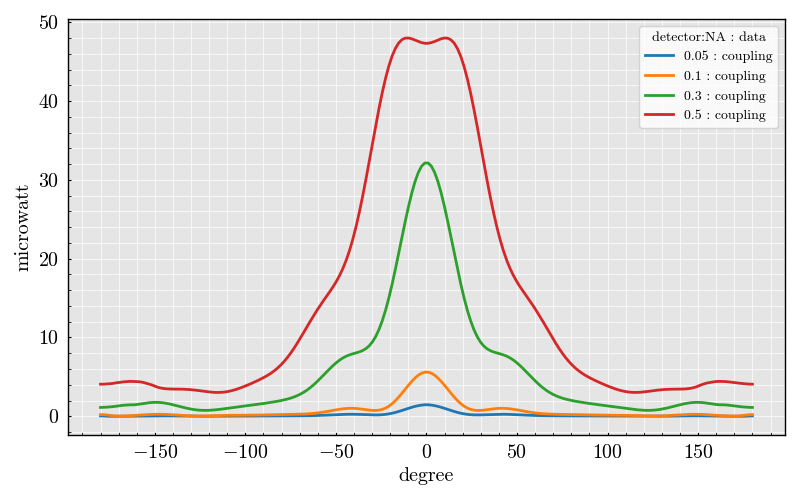Note
Go to the end to download the full example code.
Cylinder: Goniometer#
This example demonstrates how to use a goniometer setup to measure and visualize the coupling efficiency as a function of angular displacement for cylindrical scatterers using PyMieSim.
Importing the package dependencies: numpy, PyMieSim
import numpy as np
from TypedUnit import ureg
from PyMieSim.experiment.detector import Photodiode
from PyMieSim.experiment.scatterer import Cylinder
from PyMieSim.experiment.source import Gaussian
from PyMieSim.experiment import Setup
from PyOptik import Material
source = Gaussian(
wavelength=1200 * ureg.nanometer, # 1200 nm
polarization=90 * ureg.degree, # Polarization angle in ureg.degrees
optical_power=1e-3 * ureg.watt, # 1 milliureg.watt
NA=0.2 * ureg.AU, # Numerical Aperture
)
scatterer = Cylinder(
diameter=2000 * ureg.nanometer, # 2000 nm
property=Material.BK7, # Material of the cylinder
medium_property=1 * ureg.RIU, # Refractive index of the surrounding medium
source=source,
)
detector = Photodiode(
NA=[0.5, 0.3, 0.1, 0.05] * ureg.AU, # Array of Numerical Apertures for the detector
phi_offset=np.linspace(-180, 180, 200)
* ureg.degree, # Angular displacement from -180 to 180 ureg.degrees
gamma_offset=0 * ureg.degree, # Gamma offset in ureg.degrees
sampling=400 * ureg.AU, # Number of sampling points
polarization_filter=None, # No polarization filter
)
experiment = Setup(scatterer=scatterer, source=source, detector=detector)
dataframe = experiment.get("coupling", scale_unit=True)
dataframe.plot(x="detector:phi_offset")

<Figure size 800x500 with 1 Axes>
Total running time of the script: (0 minutes 0.405 seconds)
